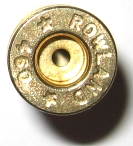
As a Real Guns visitor, you may have run across some past articles that address the subject of the 45 Super. Regardless the politics surrounding the cartridge, and subsequent debates, the Super provides a simple approach to adding a lot of punch to a select group of modified 1911 type pistols. I enjoyed shooting and loading the cartridge, but ran out of recoil spring rates and other mechanical slide dampening methods before feeling comfortable shooting the cartridge extensively in my firearms. The 460 Rowland cartridge, with a conversion kit produced by Clark Custom Guns, Inc., is purported to significantly outperform the 45 Super, while providing a more effective approach toward controlling slide movement, and a bit more safety assurance with its longer than 45 ACP case length.
| Cartridge | Bullet Weight Grains |
Velocity ft/sec |
Energy ft/lbs |
| 460 Rowland | 185 | 1500 | 925 |
| 460 Rowland | 200 | 1450 | 934 |
| 460 Rowland | 230 | 1340 | 917 |
| 45 Super | 185 | 1300 | 694 |
| 45 Super | 200 | 1200 | 639 |
| 45 Super | 230 | 1100 | 617 |
| 44 Rem Mag | 210 | 1250 | 729 |
| 44 Rem Mag | 240 | 1180 | 741 |
I thought the table might put the Rowland cartridge into context with several other powerful rounds. The Rowland can deliver real performance from a 5″ barrel 1911 type gun, more than the Super and more than the 44 Remington Magnum, which typically requires a much longer revolver for optimal performance. Big bores can show significant striking force gains from relatively modest velocity improvements. The X frame S&W 500 and 460 rounds can deliver even more that those indicated within the table, but with 18″ long 5 lb guns. The 460 Rowland can perform accurately from a 2 lb reasonably compact slab sided auto.
An abridged background and foundation
I’ll skip a rote history; I do not know Johnny Rowland, the cartridge’s developer, nor do I know the specifics of the relationship between Rowland and Clark Custom Guns. I do know there was a joint development effort which yielded guns, conversion kits and ammo for the 460 Rowland. If you hit Google, enter “Taffin +Rowland”, you’ll locate Taffin’s excellent original coverage of the 1999 product release and firearm-cartridge evaluation. Portions of this information also appear on Clark’s site. Where Taffin provided expert and experienced insight into this combination, I will be going at the 460 Rowland with all the skill and knowledge of a guy who had to call Clark Custom Guns twice, just to understand the difference between the Colt Standard and Gold Cup conversion kits; they are very patient people. My intention is to walk through the specifics of a gun conversion, make some personal observations, do a little handload development, and wrap up with some chronographed range testing. Everything will be covered within two parts.
460 Rowland gun, kit and cartridge availability
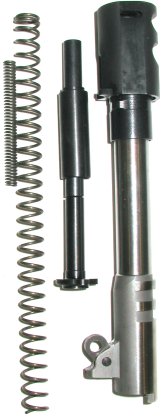 The 460 Rowland cartridge is not an upstart, both kits and brass have been commercially available for over 6 years and the round shows no signs of fading away. While primarily associated with 1911 type autoloaders, the cartridge is suitable for use in a variety of gun types including the Ruger Blackhawk, the S&W 25/625 and a Mech-Tech kit that converts a 1911 type gun into a 460 Rowland chambered carbine. All are available as complete guns, or as converted customer guns in a variety of configurations directly from Clark. Customers, owning any of the approved 1911 type guns, may purchase a drop-in 1911 kit or the Mech-Tech carbine conversion directly from Clark Custom Guns, or from Brownells. The Clark site has a full list of guns approved for conversion as well as all available kits. When I placed my order, kits were available for: Government Models and clones, the short barrel Commander and the Colt Gold Cup / Enhanced which has a narrow barrel hood 0.375″~0.380″ compared to a standard 0.445″ approx.. My Kimber Gold Match required the standard kit. All kit barrels are stainless match, however, the compensator can be specified as 4140 chrome moly or 416 stainless. The complete kit contains: barrel, bushing, link, link pin, compensator, 24 lb Wolff spring kit, 2 piece guide rod, plus a bushing wrench and Allen wrench. The retail price for all kits is $275 and each contains only components that play a necessary role in the conversion.
The 460 Rowland cartridge is not an upstart, both kits and brass have been commercially available for over 6 years and the round shows no signs of fading away. While primarily associated with 1911 type autoloaders, the cartridge is suitable for use in a variety of gun types including the Ruger Blackhawk, the S&W 25/625 and a Mech-Tech kit that converts a 1911 type gun into a 460 Rowland chambered carbine. All are available as complete guns, or as converted customer guns in a variety of configurations directly from Clark. Customers, owning any of the approved 1911 type guns, may purchase a drop-in 1911 kit or the Mech-Tech carbine conversion directly from Clark Custom Guns, or from Brownells. The Clark site has a full list of guns approved for conversion as well as all available kits. When I placed my order, kits were available for: Government Models and clones, the short barrel Commander and the Colt Gold Cup / Enhanced which has a narrow barrel hood 0.375″~0.380″ compared to a standard 0.445″ approx.. My Kimber Gold Match required the standard kit. All kit barrels are stainless match, however, the compensator can be specified as 4140 chrome moly or 416 stainless. The complete kit contains: barrel, bushing, link, link pin, compensator, 24 lb Wolff spring kit, 2 piece guide rod, plus a bushing wrench and Allen wrench. The retail price for all kits is $275 and each contains only components that play a necessary role in the conversion.
Brass may be purchased from Clark, or Starline, and virtually any reseller of Starline brass. Georgia-Arms ammo, sold through Clark, is available through either company. The lack of other commercial loaders isn’t much of an indication of cartridge success or failure. It takes a tremendous amount of time, capital and market inertia to establish a cartridge, even the major gun and ammo guys wrestle with the problem – When was the last time you rushed out to buy a box of 376 Steyr or 7mm Remington SAUM ammo?
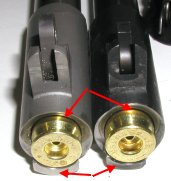 The difference in hood width between standard and Colt Gold Cup barrels is pretty obvious in this picture; the wider standard barrel hood, left lower arrow, compared to the Colt Gold Cup barrel, arrow right. The hood must clear a relief in the slide while providing lateral support to the barrel. The upper set of arrows illustrates the portion of the cartridge case that is unsupported. A relief is ground or machines into the breech end of the barrel to facilitate reliable feed, this is pretty much standard on these guns. Clark does offer a Para/Clark ramped version of the kit that provides full case support, however, its use requires fitting by a gunsmith and permanently alters the gun. To place the case support issue into perspective, I’ve put lots of Super rounds through my guns with the standard ramp and I have never had a case blow out or bulge where it extends from the barrel.
The difference in hood width between standard and Colt Gold Cup barrels is pretty obvious in this picture; the wider standard barrel hood, left lower arrow, compared to the Colt Gold Cup barrel, arrow right. The hood must clear a relief in the slide while providing lateral support to the barrel. The upper set of arrows illustrates the portion of the cartridge case that is unsupported. A relief is ground or machines into the breech end of the barrel to facilitate reliable feed, this is pretty much standard on these guns. Clark does offer a Para/Clark ramped version of the kit that provides full case support, however, its use requires fitting by a gunsmith and permanently alters the gun. To place the case support issue into perspective, I’ve put lots of Super rounds through my guns with the standard ramp and I have never had a case blow out or bulge where it extends from the barrel.
The 460 Rowland Case…hmmm
 The 460 Rowland case is longer than the max standard 45 ACP (L-R 45 ACP, 45 ACP +P, 45 Super, 460 Rowland), 0.960″ versus 0.898″. This increase is not intended to increase case capacity, as the maximum overall cartridge length specification is the same for all at 1.275″. I noticed Accurate Arms cartridge data indicates 1.337″ as the maximum overall cartridge length, but my firearms and bullet selection suggest 1.275″ as appropriate for maximum. The only purpose served by the extended Rowland case is to prevent it from being chambered in guns not properly prepared to handle the cartridge, not unlike Marlins decision to wrap a belt around the high pressure 450 Marlin to keep it out of 45-70 Gov’t chambers. I think this is a good move and this touches on a a major flaw in the 45 Super concept. If someone says, “A Kimber Gold Match with a very heavy recoil spring and already containing the miscilanious parts included with a 45 Super kit, can be tuned for the Super for about 8 bucks”, people hear, “Yes, by all means, feel free to shoot 45 Super ammo out of your unmodified Glock”. Can’t do that with the Roland. We’ll, I should never say “can’t”.
The 460 Rowland case is longer than the max standard 45 ACP (L-R 45 ACP, 45 ACP +P, 45 Super, 460 Rowland), 0.960″ versus 0.898″. This increase is not intended to increase case capacity, as the maximum overall cartridge length specification is the same for all at 1.275″. I noticed Accurate Arms cartridge data indicates 1.337″ as the maximum overall cartridge length, but my firearms and bullet selection suggest 1.275″ as appropriate for maximum. The only purpose served by the extended Rowland case is to prevent it from being chambered in guns not properly prepared to handle the cartridge, not unlike Marlins decision to wrap a belt around the high pressure 450 Marlin to keep it out of 45-70 Gov’t chambers. I think this is a good move and this touches on a a major flaw in the 45 Super concept. If someone says, “A Kimber Gold Match with a very heavy recoil spring and already containing the miscilanious parts included with a 45 Super kit, can be tuned for the Super for about 8 bucks”, people hear, “Yes, by all means, feel free to shoot 45 Super ammo out of your unmodified Glock”. Can’t do that with the Roland. We’ll, I should never say “can’t”.
All cartridge descriptions indicated the 460 Rowland case produced by Starline is thicker, heavier than the standard ACP; excellent marketing words. It’s not that I am a distrusting soul, but I couldn’t help sectioning a few cases just to see, comparatively speaking, what was going on inside of these cases and what made the Rowland case so much stronger.
|
Source |
Winchester | Starline | |||
|
Cases |
Std ACP | +P | Super | Rowland | |
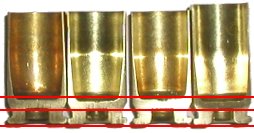 |
Primer Pocket Depth | 0.116 | 0.121 | 0.124 | 0.124 |
| Web Thickness | 0.067 | 0.059 | 0.074 | 0.054 | |
| Case Head to Web | 0.185 | 0.185 | 0.195 | 0.178 | |
| Overall Case Length | 0.886 | 0.894 | 0.896 | 0.956 | |
Before I go any further, I want to make it clear that this is not an exposé piece on component suppliers, this is just me pursuing an explanation for something that came up differently than expected. I did call Starline and was told the Rowland is made from the same basic cup as the Super and they should be essentially the same in the web/case head area. I was told over 0.050″ at the web should be fine and that the Rowland was heat treated slightly different than the 45 ACP cases. Maybe my Starline Super brass is old and thicker than current production? I did go back and section other sample of other manufacturer’s standard brass, mostly with similar results. The thinnest web I found was very old Remington 45 SWC target ammo that measured 0.052″. I took a look at wall thickness, but all brands were generally the same +/- 0.0005. My conclusion is that Rowland cases are no thicker than production 45 ACP cases from other manufacturers, and I have no measured recent lots of 45 Super from Starline to see where they fall dimensionally. The Starline Rowland cases may very well be stronger through heat treat or selection of raw material brass alloy, and I know I have never had a problem with Starline brass across a lot of cartridges I handload. We’ll see what live fire testing brings.
All 1911 type guns should not be converted for the Rowland
MAP specification for the .45 ACP, .45 ACP +P, 45 Super and 460 Rowland from various sources are 21,000 PSI, 23,000 PSI, 28,000 PSI, and 40,000 C.U.P respectively. The last unit of measurement is inconsistent with PSI, however, data appearing elsewhere can bring this pressure spec into context. Accurate Arms, the company assisting Clark in developing load data, indicates the cartridge was developed to the 45 Winchester Magnum 40,000 C.U.P. pressure limit, a cartridge with a CIP standard of 39,885 PSI. The maximum loads that serve as the basis for the 460 Rowland cartridge’s advertised performance, generate pressure levels below the 40,000 CUP level, more typically the 34,000 ~ 38,000 range. While in sharp increase to the standard 45 ACP, the Rowland is not much different from other current high intensity handgun cartridges for guns of similar design: 40 Super 38,000 PSI, 400 Cor-Bon 33,500 PSI, 357 SIG 40,000 PSI, 38 Super Auto +P 36,500 PSI, 10mm Auto 33,400 PSI, 9mm Luger +P 38,500 PSI, 40 S&W 35,000 PSI.
Clark Custom Guns addresses the increase pressure of the 460 Rowland in several ways, the first by limiting 1911 conversion candidates to only quality firearms. As of this writing, this includes:
Colt Government Model
Colt 1991A1 Government
Colt Gold Cup Government
Colt Gold Cup Commander
Colt Enhanced 1911 Government
Colt Enhanced 1911 Commander
Kimber 1911 Government
Norinco 1911 Government
Springfield Armory 1911-A1 Government
Clark has not developed kits for Glock, Ruger, Sig Sauer, H&K and S&W 45 Semi Auto Pistols, and yet I do not feel distressed over the issue, even though I own some of these. While catalogued 1911 kits may fit, Clark specifically does not recommend attempting conversions on firearms from: Israeli Arms International, Auto Ordnance, Llama, AMT, Charles Daly or “GI” 1911. Concerns noted are inconsistent spot heat treating and soft slide top lugs. Clark had produced a kit for Para Ordnance guns, but they have since discontinued the version citing reliability problems. The 460 Rowland, more than any +P or Super load, taxes the limits of the 1911 design. As a point of reference, the pressure equal of the 460 Rowland, the 45 Winchester Mag, was intended for the heavy gas operated Wildey Mag, a design were operation would be naturally dampened. In order to use the same cartridge in the L.A.R. Grizzly, a more traditional short recoil – locked breech design gun, the manufacturer had to rely on some special steps to assure adequate strength: better grade of raw materials, closer fitting parts, in-house Rockwell testing, process certification, reduced firing pin diameter and more closely matched breech opening, maximum lock up surface and contact, and an increased mass slide. Steps weren’t taken to thicken chamber or breech wall thickness, steps were taken to prevent the slide from being beaten into submission, and to prevent primer flow into the breech face. Clark addressed the potential for over zealous slide movement problem by hanging a compensator on all 460 Rowland barrels. The compensator causes a partial pressure drop before the barrel drops and releases the slide, which dampens the slide’s movement. The compensator is so effective, the 460 Rowland, with 30% more chamber pressure and 15%~20% more velocity, uses a lower recoil spring rate than a typical 45 Super conversion. The compensator approach even allows for the conversion of the shorter 4.25″ barrel Colt Commander.
The conversion. How did it go….really?
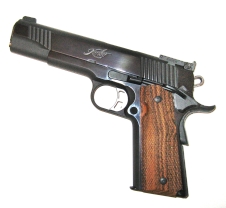
It’s not that I don’t like my Kimber Gold Match, I really do. I just happen to think it is well made and can hold up to a lot of abuse. Naturally, it was the only candidate for this project. Because the Kimber had been the basis for my 45 Super and +P load development, I had installed a Sprinco guide rod system with its integrated variable rate spring. I like the Sprinco set up better than a Shok-Buff because is yields to slide travel, unlike solid material, and stores energy to assist in slide return. I used this 12.5lb secondary spring in concert with a 22lb Wolff spring for full up 45 Super Loads. The Clark 460 Rowland kit includes a full length guide rod as well as a 24 lb Wolff spring, a set up tuned for the compensator and 460 Rowland, so I used these parts for the kit installation rather than those listed above. At some point, I may go back and try it with the Sprinco part in place and a proportionally lower rate recoil spring.
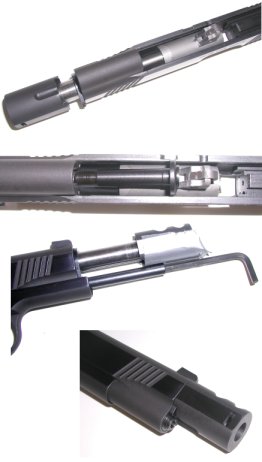
The Clark kit comes with instructions from Johnny Rowland; well not personally, but his name is at the top of the instructions sheet. The piece covers a generic 1911 installation with a full length guide rod. The kit also contains Clark Custom Gun instructions for the 2 piece full length guide rod, which overlap the Rowland instructions for the guide rod installation. The path to follow is the Clark instruction.
If there is anything noteworthy about the installation, it is that there is nothing noteworthy about the installation, every thing fits as good as factory parts and most of the assembly is like any other 1911. The gun is disassembled, barrel, bushing, recoil spring and guide rod are removed. Then the new barrel, complete with it’s threaded on compensator and bushing are slipped into place. The rear half of the guide rod is slipped into place, notched side facing the barrel, and the slide is reinstalled on the gun.
I suggest putting a piece of vinyl tape around the compensator before assembly to protect the finish…just in case. Using the Clark supplied Allen wrench, the front part of the guide rod is installed and tightened, the recoil spring (small diameter coil into the gun) us put in place, then the recoil spring plug. This part will make you a man, or, if you are not careful, something a little less. I have a hunk of 2×4 nailed to my shop wall. I catch the plug end on the board edge and push it into place, so the muzzle can pass by as I compress the spring, then I rotate the bushing to trap the plug. It all looks right when complete and closely matches the Kimber’s finish. neat.
460 Rowland – Summary
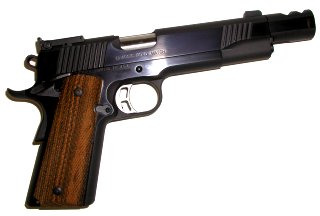
So far, so good. The gun went together pretty easily, although it is waiting live fire testing. The lock up is tight and there is some hefty heavy spring loading of the slide , but I think it will be fine in use. The gun grew from 8.75″ to 10.25″ in overall length and from 2.50 lbs (picked up 2 ounces when I added the steel mainspring housing in an earlier project) to 2.75 lbs. The Kimber has become one of those guns you really could throw if you ran out of ammo and do some serious damage. In reality, steel 1911 guns are not intended to be light weights, but the heft will help absorb recoil and hold it all together. In this configuration, the Kimber is incredibly steady on target and it feel very balanced.
I am working on the fun part, handloads. I will save the specifics for the next and final part, but I did want to mention that the loading dies are standard 45 ACP and everything else remains the same. Hopefully I can get the same performance numbers used in promotion of the combination, and maybe come up with a few of my own using a broader selection of powder and bullets. We’ll see…we shall see.
More “The 460 Rowland…Whoa Mama!”:
The 460 Rowland…Whoa Mama! Part 1
The 460 Rowland…Whoa Mama! Part 2 – Conclusion
460 Rowland handload Data
Thanks,
Joe

Email Notification